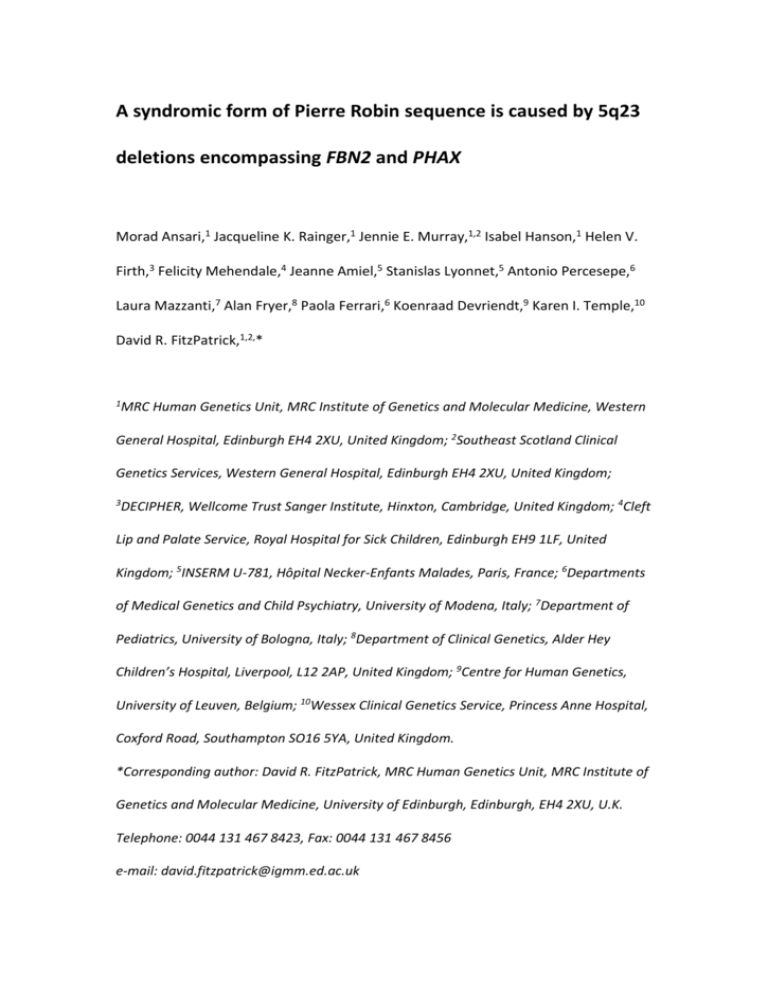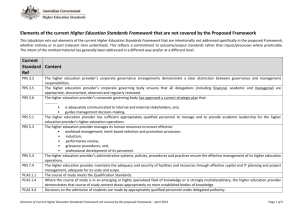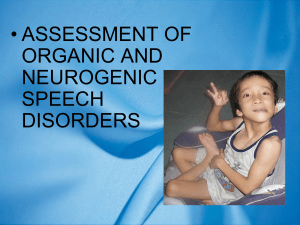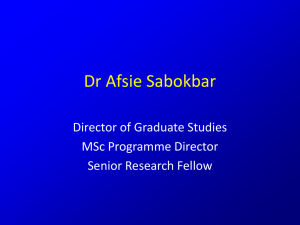Pierre Robin sequence (PRS) is a congenital
advertisement

A syndromic form of Pierre Robin sequence is caused by 5q23 deletions encompassing FBN2 and PHAX Morad Ansari,1 Jacqueline K. Rainger,1 Jennie E. Murray,1,2 Isabel Hanson,1 Helen V. Firth,3 Felicity Mehendale,4 Jeanne Amiel,5 Stanislas Lyonnet,5 Antonio Percesepe,6 Laura Mazzanti,7 Alan Fryer,8 Paola Ferrari,6 Koenraad Devriendt,9 Karen I. Temple,10 David R. FitzPatrick,1,2,* 1 MRC Human Genetics Unit, MRC Institute of Genetics and Molecular Medicine, Western General Hospital, Edinburgh EH4 2XU, United Kingdom; 2Southeast Scotland Clinical Genetics Services, Western General Hospital, Edinburgh EH4 2XU, United Kingdom; 3 DECIPHER, Wellcome Trust Sanger Institute, Hinxton, Cambridge, United Kingdom; 4Cleft Lip and Palate Service, Royal Hospital for Sick Children, Edinburgh EH9 1LF, United Kingdom; 5INSERM U-781, Hôpital Necker-Enfants Malades, Paris, France; 6Departments of Medical Genetics and Child Psychiatry, University of Modena, Italy; 7Department of Pediatrics, University of Bologna, Italy; 8Department of Clinical Genetics, Alder Hey Children’s Hospital, Liverpool, L12 2AP, United Kingdom; 9Centre for Human Genetics, University of Leuven, Belgium; 10Wessex Clinical Genetics Service, Princess Anne Hospital, Coxford Road, Southampton SO16 5YA, United Kingdom. *Corresponding author: David R. FitzPatrick, MRC Human Genetics Unit, MRC Institute of Genetics and Molecular Medicine, University of Edinburgh, Edinburgh, EH4 2XU, U.K. Telephone: 0044 131 467 8423, Fax: 0044 131 467 8456 e-mail: david.fitzpatrick@igmm.ed.ac.uk Abstract Pierre Robin sequence (PRS) is an etiologically distinct subgroup of cleft palate. We aimed to define the critical genomic interval from five different 5q22-5q31 deletions associated with PRS or PRS-associated features and assess each gene within the region as a candidate for the PRS component of the phenotype. Clinical arraybased comparative genome hybridisation (aCGH) data were used to define a 2.08Mb minimum region of overlap among four de novo deletions and one mother-son inherited deletion associated with at least one component of PRS. Commonly associated anomalies were talipes equinovarus (TEV), finger contractures and crumpled ear helices. Expression analysis of the orthologous genes within the PRS critical region in embryonic mice showed that the strongest candidate genes were FBN2 and PHAX. Targeted aCGH of the critical region and sequencing of these genes in a cohort of 25 PRS patients revealed no plausible disease-causing mutations. In conclusion, deletion of ~2Mb on 5q23 region causes a clinically recognisable subtype of PRS. Haploinsufficiency for FBN2 accounts for the digital and auricular features. A critical region for TEV is distinct and telomeric to the PRS region. The molecular basis of PRS in these cases remains undetermined but haploinsufficiency for PHAX is a plausible mechanism. [MAX 200 WORDS] Key words: Pierre Robin sequence; Cleft palate; Congenital contractural arachnodactyly; 5q deletion; Fibrillin 2 (FBN2); Phosphorylated adaptor for RNA export (PHAX); Talipes equinovarus; Crumpled ears; Beal syndrome 2 Introduction Pierre Robin sequence (PRS; MIM 261800) is an important clinical entity that is characterised by congenital micrognathia and glossoptosis (downward displacement of the tongue) with airway obstruction and a U-shaped cleft of the soft palate (Evans et al., 2006; van den Elzen et al., 2001). PRS is hypothesised to be a primary defect in growth of the embryonic mandible, which results in an abnormal positioning of the tongue such that it obstructs the normal midline fusion of the posterior palatal shelves which normally occurs at ~56 gestational days in humans (Gordon et al., 2009; van den Elzen et al., 2001). The lower jaw is formed from cranial neural crest cells located within the mandibular swelling of the first pharyngeal arch and it is possible that some cases of PRS are caused by abnormal development of neural crest cells or of the cartilaginous structures derived from them (Gordon et al., 2009). The oral anomalies associated with PRS often cause breathing and feeding difficulties resulting in failure to thrive. In severe cases, obstruction of the upper airway by the tongue can be fatal (Evans et al., 2006; van den Elzen et al., 2001). PRS commonly occurs as part of a multisystem developmental disorder (Holder-Espinasse et al., 2001). The most common syndrome diagnoses identified in PRS cases are Stickler syndromes type I (MIM 108300), type II (MIM 604841) and type III (MIM 184840) caused by mutations in the COL2A1, COL11A1 and COL11A2 genes respectively (Evans et al., 2006; Holder-Espinasse et al., 2001; Snead and Yates, 1999; van den Elzen et al., 2001). Less commonly PRS may be associated with velo-cardio-facial syndrome (VCFS; MIM 192430), which is caused by a recurrent non-allelic homologous recombination induced deletion of 22q11.2. This deletion encompasses the TBX1 gene which is required for normal FGF8 and BMP4 signalling during mandibular development (Aggarwal et al., 2010). Non-syndromic PRS may 3 also be associated with heterozygous disruption of long-range cis-regulatory elements of either SOX9 (Benko et al., 2009) or SATB2 (Rainger et al., 2014). In at least half of PRS cases the cause remains to be determined. Here we describe a new clinically recognisable syndrome with PRS or PRS-associated features, joint contractures, long, thin fingers and crumpled ears. Isolated congenital contractural arachnodactyly (CCA, 121050) may be caused by mutations in the fibrillin 2 gene, FBN2 (Tuncbilek and Alanay, 2006). Molecular characterisation of five unrelated 5q deletions associated with PRS and CCA enabled us to define a critical region of 2.08 Mb at 5q23. Ten genes including FBN2, map within the critical region. FBN2 and PHAX were considered the strongest candidate genes for PRS based on the developmental expression pattern in embryonic mice. A previously reported case of an intragenic FBN2 mutation had also been associated with cleft palate and micrognathia in a child with CCA (Belleh et al., 2000). However, no plausibly pathogenic mutations were detected in screening a cohort of 25 PRS cases thus the molecular mechanism underlying the PRS component of PRS with CCA remains unclear. Materials and methods Case Ascertainment Each 5q22-23 deletion was ascertained via routine clinical genetics investigations within a regional genetics service laboratory using array-based comparative genomic hybridisation (aCGH) with or without conventional cytogenetic analysis and fluorescent in situ hybridisation (FISH) to metaphase chromosomes. The FISH and aCGH analyses were performed in different clinical and research 4 laboratories. The overlapping phenotype was noted following the submission of deletions from different centres to the DECIPHER database (Firth et al., 2009). A panel of 25 PRS cases with no deletions detected on aCGH were screened for intragenic mutations in FBN2 and PHAX as a subset of a larger existing study group collected by DRF, JA and SL. This study was performed under ethical approval provided by the UK Multiregional Ethics Committee (Reference: 06/MRE00/77). Fluorescence in situ hybridisation (FISH) For Families 1 and 2 the FISH was performed on metaphase chromosomes prepared from lymphocytes as described elsewhere (Fantes et al., 2008). The BAC clone RP11-351A8, which spans FBN2, was selected from the UCSC Human Genome Browser (http://genome.ucsc.edu) and the probe was labelled with biotin-16-dUTP (Roche) by nick translation (Fantes et al., 2008). Following hybridization, slides were mounted with a drop of Vectorshield antifadent containing DAPI (Sigma). Antibody detection was carried out by fluorescent microscopy using a Zeiss Axioscop microscope. Images were collected using a cooled CCD (charged coupled device) camera (Smart-Capture software). Array-based comparative genomic hybridisation (aCGH) Genome-wide aCGH was performed in clinically accredited laboratories using a variety of different array platforms including the Bluefuse CytoChip V1.1 1Mb BAC array (BlueGnome Ltd, UK). Targeted DNA copy number analysis was performed using a customised oligonucleotide microarray (Agilent Technologies) consisting of 44,000 60-mer oligonucleotide probes, designed using eArray (Agilent Technologies), encompassing (hg19): FBN2 and PHAX (chr5:125,172,101-128,172,101), SOX9 (chr17:67,988,4055 71,988,405), SATB2 (chr2:198,591,755-201,191,755), TBX1 (chr22:19,720,00019,820,000) and TBX22 (chrX:78,613,344-79,963,344) with an average probe spacing of 260 bp. “Dye-swap” experiments were performed for each patient sample to reduce the variation related to labelling and hybridisation efficiencies. Briefly, 1 µg of genomic DNA from the patient and the control (pool of 5 samples) was digested with AluI and RsaI enzymes, and the digested DNA was labelled with Cyanine 3-dUTP or Cyanine 5-dUTP in dye-swap reactions, followed by hybridization, as per the manufacturer’s instructions (Agilent Technologies). Slides were scanned using an Axon GenePix 4000B scanner (Molecular Devices). Images were extracted and normalised using the linear-and-Lowess normalisation module implemented in the Feature Extraction software (Agilent Technologies). An R-script was used to correct for systematic differences in probe efficiencies seen on a particular array using the "self-self" microarray data (T. Fitzgerald, personal communication). The GC bias (or wave profile) was also corrected using a 500 bp window around each probe (Marioni et al., 2007). Copy number analysis was carried out with DNA Analytics software (Agilent Technologies) using the aberration detection module (ADM)-2 algorithm (Lipson et al., 2006) with a threshold of 6 and at least 5 consecutive probes showing a change in the copy number. Expression pattern of candidate genes For the 3′ untranslated region (UTR) of each of the genes in the critical region, primers with 5′ T7 binding sites (Supp. Table S3) were used for PCR amplification of mouse genomic DNA template. Digoxigenin (DIG, Roche)-labelled antisense riboprobes were generated by in vitro transcription using T7 RNA polymerase. WISH analysis was performed on mouse embryos at 9.5, 10.5, 11.5 and 12.5 gestational days as previously described (Rainger et al., 2011). 6 Mutation analysis of the FBN2 and PHAX genes Genomic DNA was used as a template for whole genome amplification using GenomiPhi V2 DNA Amplification Kit (GE Healthcare Life Sciences) prior to mutation screening. The amplicons encompassing the coding exons and the intronic splice junctions were designed using ExonPrimer (http://ihg.gsf.de/ihg/ExonPrimer.html) or by manual means. Oligonucleotide sequences are available on request. Forward and reverse oligonucleotides were tagged with the universal primer 5´- GTAGCGCGACGGCCAGT or 5´CAGGGCGCAGCGATGAC, respectively. All amplicons were amplified by PCR comprising 20 ng whole-genome amplified DNA, 1X ReddyMix Custom PCR Master Mix (Thermo Scientific), 1X GC-rich Solution (Roche Diagnostics Ltd), 0.4 µM forward oligonucleotide and 0.4 µM reverse oligonucleotide, in a total volume of 12 µl. A uniform PCR cycling protocol was performed: 95 °C for 5 minutes; 32 cycles of 94 °C for 1 minute, 58 °C for 1 minute, 72 °C for 1 minute; 72 °C for 10 minutes. The products were visualised using agarose gel electrophoresis to ensure adequate yield and proper sizing of each exon fragment. Bidirectional direct sequencing using the universal primers was performed using BigDye Terminator v3.1 Cycle Sequencing Kit and resolved on an ABI 3730 DNA Analyzer (Applied Biosystems). Sequence files were analysed with Mutation Surveyor v3.30 (SoftGenetics). The genomic sequence identifier used for both FBN2 and PHAX is NC_000005.10. Results 7 Cases with overlapping deletions Family 1, Individual 1 DECIPHER Number 1051/248164 Cytogenetic and clinical aspects of this individual have been previously reported (Garcia-Minaur et al., 2005). He has a deletion of 5q22.3-q23.3 associated with multiple congenital anomalies including Pierre Robin sequence, crumpled ears and congenital contractural arachnodactyly (Fig. 1A-C). The original mapping of the deletion was performed using metaphase FISH analysis. Here we used CytoChip aCGH to show that this deletion has a minimum size of (chr5:114,413,274129,422,143, hg19) (Fig. 2). He was reviewed at the age of 20.7 years. He lives with his parents. He has moderate intellectual disability and has significant problems with anxiety and depression. He continues to have significant joint hypermobility with recurrent bilateral patellar dislocations. He has chronic hip pain without radiological evidence of osteoarthritis. He has significant visual impairment as a result of his colobomata and suffers from chronic gastroesophageal reflux which requires treatment with a proton pump inhibitor. Family 2, Individual 2 DECIPHER Number 2224/260667 This case was a first-born male to healthy unrelated parents. Talipes equinovarus had been noted on antenatal scans. He was born at term pregnancy with a birth weight of 3,300 g (25th centile). There was airway compromise immediately on delivery due to PRS (Fig. 1D-I). He was also noted to have crumpled ear helices, arachnodactyly and distal arthrogryptosis of the left 3rd and 4th digits. As well as bilateral talipes equinovarus there was also developmental dysplasia of both hips. The right hip required reduction under general anaesthetic at 8 months of age. He has had 8 severe gastroesophageal reflux from birth resulting in poor weight gain. He required nasogastric tube feeding from birth and symptoms only improved following insertion of a gastro-jejunostomy at 8 months of age. Echocardiogram revealed mild branch stenosis of pulmonary arteries which resolved by 1 year of age. He had bilateral strabismus. Growth measurements at 21 months: weight and height on the 9th centile and head circumference on the 25th centile. Psychomotor development is delayed although the skeletal abnormalities and cleft palate have hindered his progress. At 3 years of age he was able to walk with splints and although he had no speech he did communicate well through signing. In view of persistent retching an MRI brain and spine were performed and this demonstrated general paucity of cerebral white matter and a 7 mm wide syrinx extending from T6 to T9. He also developed thoracolumbar scoliosis. At the age of 6.2 years he is in reasonable general health and is attending school. He uses a large number of words appropriately using either signing or via a speech output device (Go Talk 9+). He continues to have complete intolerance of oral food intake and is currently fed via a percutaneous gastrostomy. Family 3, Individual 3 DECIPHER Number 785 This female case is the second child of healthy, unrelated parents. She was born at term pregnancy, with a birth weight of 3,470g (50th centile), length 50 cm (50th centile) and head circumference 37 cm (98th centile). Cleft palate was identified soon after delivery as was camptodactyly of fingers 2-3 on both sides, and left talipes equinovarus. There were two small pre-auricular tags on the left and the right ear was mildly dysplastic. A small atrial septal defect was also identified on echocardiogram following auscultation of a murmur. No further problems with feeding or airway compromise have been reported after undergoing surgical correction of the cleft 9 palate. Assessment of her psychomotor development showed a mild delay: on the Bayley mental scale, her mental level was 22 months at a chronological age of 28 months (developmental index of 76). She walked at the age of 25 months. There is no family history of learning difficulties or congenital malformations. At the age of 2.5 years, her growth was at the 3rd centile for weight and length, and head circumference was at the 3rd-10th centile (Fig. 1J-K). At the age of 9 years, she weighed 22 kg (3rd centile) with a height of 119.5 cm (below 3rd centile) and a head circumference of 50.5 cm (10th – 25th centile). She has some dysmorphic features including epicanthic folds, hypertelorism and a widened nasal bridge (Fig. 1L). Both ears have a marked prominence and angulation of the antihelical stem and there is also marked prominence of the superior crus and a notch in the helix on the right (Fig. 1M-N). Family 4, Individuals 4 and 5 DECIPHER number 2199 Individual 4 is male who was born at 30 weeks gestation weighing 1,600 g. A cleft palate and hypospadias were noted at birth. When last assessed aged 5 years, he was noted to have mild global delay in his development, distal arthrogryposis, unilateral radioulnar synostosis and overfolded outer margin of both ears. The 5q deletion was noted on investigation of his developmental delay (Fig. 2). His mother, individual 5 carries the same deletion (Fig. 2). She has a high narrow palate with no cleft. She has distal arthrogryposis and radioulnar synostosis bilaterally. She has no intellectual disability. Her father, who has not been tested for the deletion also had cleft palate. Family 5; Individual 6 DECIPHER 254582 10 The propositus is a first-born male to healthy unrelated parents. After an uneventful pregnancy he was born at 39 weeks with caesarean delivery due to foot presentation. His growth measurements at birth were: weight 2,555 g (5th centile), length 45 cm (<5th centile) and head circumference 34 cm (25th centile). Apgar score was 8 and 9 at 1 and 5 min, respectively. Bilateral talipes equinovarus, penoscrotal inversion, right cryptorchidism were noted (Fig. 1O-R). Mild dysmorphisms were present: bitemporal narrowness, horizontal ocular rhyme, bulbous nose with anteverted nares, micrognathia, glossoptosis, and slender hands and toes (Fig. 1O-R). Severe developmental dysplasia of both hips required surgical correction at the age of 1 year. During infancy, the patient suffered from severe feeding problems, causing several hospitalisations and from severe sleep disorders. He had bilateral strabismus. At 3 years of age he started walking and at 5.6 years he still displayed walking and balance problems. First words were spoken at 3 years. At 5 years of age he presented with episodes of focal epilepsy with secondary generalisation, controlled with combination therapy (oxcarbazepine and clonazepam). Brain and spine scans were performed, which demonstrated an abnormal orientation of the hippocampus and a syringomyelia extending from the 5th thoracic vertebra to the lower extremity of the cord. He was last assessed at the age of 11.8 years when his growth parameters were: height 137.2 cm (3th centile), weight 33.3 kg (50th centile) and head circumference 49.2 cm (>3th centile). He suffers from severe intellectual disability. Defining a PRS-associated Critical Region The clinical features of the 6 individuals carrying a 5q22-23 deletion from Families 1-5 are summarised in Table 1. Of these individuals 4/6 had cleft palate, 3/6 had micrognathia and 3/6 had glossoptosis. Only Individual 5 from Family 4 showed no signs of PRS. All the deletion carriers showed some skeletal anomalies; 3/6 had 11 finger contractures, 3/6 had talipes equinovarus (TEV), 2/6 had hip dysplasia and 2/6 had radial ray defects. Only two of the affected individuals had crumpled ear helices. The deletions in Families 1-5 were then used to define a genomic interval of 2,079,041 bp on chr5:125,794,639-127,873,679 (hg19) that is shared by all affected individuals (Fig. 2, Supp. Table S1). We have termed this the PRS critical region. An Adjacent Deletion Defines a TEV Critical Region Distinct from the PRS Critical Region On review of the DECIPHER database (http://decipher.sanger.ac.uk) we identified an individual (DECIPHER 262426) with a de novo deletion identified using BlueGnome ISCA 60K Cytochip which was telomeric to and non-overlapping with the PRS critical region (chr5:129,439,502-135,816,459, hg19) (Fig. 2, Fig. 3, Supp. Table S2). This male case presented with global developmental delay at the age of 4 years. He had severe left sided TEV that was operated on at age 12 months. He had also suffered recurrent chest infections and gastro-oesophageal reflux requiring fundoplication, a left undescended testis requiring orchidopexy, bilateral inguinal hernia repairs, poorly developed abdominal musculature and facial dysmorphism (Fig. 3A-C). He had long toes, with his 4th toe under-riding the others and a deep crease between his first and second toes (Fig. 3D-F). He had mild joint hypermobility. His facial features were noted to be slightly reminiscent of Williams-Beuren syndrome (MIM 194050) but FISH with a probe containing the elastin gene, ELN was normal. When reviewed at 12 years of age he had developed an osteochondroma in the right popliteal fossa. 12 Expression pattern of candidate genes The expression pattern of the mouse ortholog of each candidate gene was determined in mouse embryos (Fig. 4, 5). Out of the ten genes within the PRS critical region, Gramd3, Aldh7a1, March3, Megf10 and Prrc1 showed no evidence of site- or stage-specific expression above the BM purple stain background. Lmnb1 showed some expression in the developing limbs. However, Phax and Fbn2 both showed evidence of specific expression in the first and second branchial arches (Fig. 4). Furthermore, analysis of Phax and Fbn2 expression in the 9.5 dpc mouse embryos using optical projection tomography (OPT) showed strong expression of Phax in pharyngeal arch 1 and 2 and the forebrain (Fig. 5). Phax expression was stronger in the first arch than the second, from which the jaw develops. Fbn2 was most strongly expressed in the developing somites but was also seen in the developing eye, migratory neural crest cells and in pharyngeal arch 1 and 2 (Fig. 5). Mutation analysis of FBN2 and PHAX Based on the above expression patterns we judged that FBN2 and PHAX were the strongest candidate genes for the PRS phenotype. Direct sequencing of all 65 coding exons of the FBN2 gene and 5 coding exons of PHAX, however, revealed no intragenic mutations in 25 PRS cases analysed. Discussion Individual 1 and Individual 2 both presented in the perinatal period with severe Pierre Robin sequence (PRS) and were seen by the same clinician (DRF) 13 several years apart. On the basis of the distinct clinical features in Individual 1 a clinical diagnosis of 5q23 deletion syndrome was made in Individual 2 and subsequently confirmed by metaphase FISH analysis. A review of the cytogenetic literature (Supp. Table S4) revealed that deletions of the middle part of 5q cause a wide variety of different malformations with few clear genotype-phenotype correlations (Arens et al., 2004; Courtens et al., 1998; Bennett et al., 1997; Tzschach et al., 2006). Haploinsufficiency of the 5q22-q23 region, however, is frequently associated with cleft palate (Arens et al., 2004; Garcia-Minaur et al., 2005; Courtens et al., 1998; Hastings et al., 2000). To determine the phenotypic spectrum associated with deletions of this part of the genome we have characterised six deletions of 5q which had been molecularly-positioned by aCGH and were ascertained via the DECIPHER database (Firth et al., 2009). This has allowed us to define two interesting critical regions, one for cleft palate and Pierre Robin sequence and the other for talipes equinovarus (TEV). Our interest is in defining new genes that cause craniofacial malformations and we used developmental gene expression analysis in mouse embryos to identify FBN2 and PHAX as strong candidates for aspects of the 5q23 deletion phenotype based on their specific expression pattern detected in the pharyngeal arch 1 and 2 and migratory neural crest cells. Intragenic mutations in FBN2, predominantly missense mutations, cause congenital contractural arachnodactyly (CCA; MIM 121050). The paucity of loss-offunction mutations has led to the proposal that CCA is caused by a gain-of-function mechanism; however no single mechanism has been proven (Robinson et al., 2006). In Marfan syndrome (MIM 154700), which is caused by mutations in FBN1, it is clear that loss of one copy of FBN1 through gene deletion can elicit a range of subphenotypes that are comparable in severity to those caused by amino acid 14 substitutions (Hilhorst-Hofstee et al., 2011). By analogy with FBN1, it is reasonable to propose that the arachnodactyly and mild distal arthrogryposis observed in some of the deletion cases described here is caused by loss of one copy of FBN2. FBN2 could be a candidate for PRS because fibrillins sequester and modulate the activity of TGFβ which is required for control of SOX9 expression during mandibular ossification (Ramirez and Sakai, 2010; Oka et al., 2008). Defects in TGFβ signalling cause retarded mandibular development (Oka et al., 2008). There is one report of cleft palate in a case of CCA (Belleh et al., 2000), but features of PRS appear to be otherwise absent from CCA patients with intragenic FBN2 mutations (Callewaert et al., 2009). We found no intragenic FBN2 mutations in 25 cases of PRS. It is thus difficult to assign the PRS or cleft palate component of the 5q23 deletion phenotype to haploinsufficiency of FBN2. The expression pattern of Phax in the developing pharyngeal arches was striking and made this an initially surprising candidate gene for PRS/cleft palate. PHAX, phosphorylated adaptor for RNA export, is enriched in Cajal bodies (CB) of nuclei and is involved in the intranuclear transport of small nucleolar RNA (snoRNA) to CBs and export of small nuclear RNA (snRNA) to the cytoplasm (Ohno et al., 2000). In the nucleus, PHAX acts as an adaptor between CRM1 (export receptor for proteins carrying a nuclear export signal) and CBC (cap-binding complex)-snRNA complex which is required for U snRNA export (Ohno et al., 2000). There is currently no knockout mouse model of PHAX, but its inhibition in Xenopus oocytes has been shown to result in accumulation of U snRNAs in CBs and their inability to exit into the cytoplasm (Suzuki et al., 2010). In humans, several facial dysostoses have been linked to RNA metabolism and transport: Treacher Collins syndrome (TCS, MIM 154500) is characterised by general cranioskeletal hypoplasia due to generation of 15 insufficient neural crest cells (Trainor et al., 2009). Loss-of-function mutations have been identified in TCOF1, POLR1C and POLR1D which encode nucleolar phosphoprotein Treacle, subunits of RNA polymerase I and RNA polymerase III, respectively (Valdez et al., 2004; Dauwerse et al., 2011). This implicates each of these genes in ribosome biogenesis in the highly proliferative neuro-epithelial and neural crest cells. Similarly, Nager syndrome or Nager type of acrofacial dysostosis (AFD1, MIM 154400) encompasses malformations of the craniofacial skeleton and also the limbs (Trainor and Andrews, 2013). In about 50% of cases, AFD1 is caused by haploinsufficiency of SF3B4 (Czeschik et al., 2013), which binds to pre-mRNA and U2 snRNPS as part of the U2SNP pre-spliceosomal complex involved in RNA splicing (Bernier et al., 2012). Miller syndrome or postaxial acrofacial dysostosis (MIM 263750), characterised by both craniofacial and limb anomalies, is another example of a clinically recognisable acrofacial dysostosis in which recessive mutations in DHODH result in reduced de novo pyrimidine synthesis (Rainger et al., 2012). Interestingly, inhibition of DHODH in zebrafish embryos leads to complete abrogation of neural crest development similar to Treacle (White et al., 2011). Although we did not unravel any intragenic mutations of PHAX in our patient cohort, we believe that the craniofacial malformations observed in our cases are plausibly due to haploinsufficiency of PHAX as a result of the genomic deletions encompassing it. Acknowledgments We thank the patients and their families and carers. DRF, MA and JKR are funded via programme grants to the MRC Human Genetics Unit. This study makes use of data 16 generated by the DECIPHER Consortium. Funding for the DECIPHER project was provided by the Wellcome Trust. Supplementary Material Supplementary material contains four supplementary tables and supplementary references. References Currently at the end of manuscript. 17 Table 1. The clinical features of the 6 individuals carrying a 5q22-23 deletion. FamID CaseID Array Platform CytoChip Confirmation DECIPHER ID DECIPHER ID Number of Genes Deleted FISH 1051 248164 45 2 2 chr5:124622096135437935 CytoChip & Nimblegen 135K FISH 2224 260667 73 Paternal/ maternal genotype Normal Normal Normal Sex Gestational age (weeks+days) Birth weight (g) [Z score] Birth ocipitofrontal circumference (cm) [Z score] male 37 -1.31 (2400g) male 40 -0.48 (3300g) female 40 0.23 (3470g) 11 Het (affected, case 5) male 30 +4 0.51 (1600g) -1.73 (33cm) Unknown 1.99 (37cm) 29.5cm Height (cm) [Z score] -2.76 (158.3cm) -2.23 (106cm) -2.28 (119.5cm) Weight (kg) [Z score] Age at growth measurement (years) Ocipitofrontal (head) circumference (cm) at age (yrs) [Z score] Age at last assessment (years) CRANIOFACIAL PHENOTYPE -1.72 (57 kg) 20.7 -2.65 (16.5 kg) 6.2 -1.76 (22kg) 9 -1.28 (103.8cm) -2.36 (14.3kg) 5 -0.2 (56.6) -0.67 (52.2cm) -2.33 (50.5cm) 20.7 6.2 Cleft palate Y Micrognathia Glosoptosis Deletion Coordinates (hg19) 1 1 chr5:114413274129422143 3 3 chr5:118953363131550089 Custom 1Mb BAC array PLEASE FILL 785 4 4 38 5 chr5:125794639-127873679 5 6 chr5:124363282134604995 PLEASE FILL PLEASE FILL PLEASE FILL PLEASE FILL 2199 PLEASE FILL PLEASE FILL 254582 63 Het? Normal female Unknown Unknown male 39 -1.86 (2555g) Unknown -0.95 (34cm) 0.51 (167.5cm) -1.05 (141.2cm) Unknown 39 -0.71 (34.1kg) 12.1 -1.16 (51cm) 0.01 (55.5cm) -3.28 (49.8cm) 9 5 39 12.1 Y Y Y Y Y Y Y N N N N high narrow palate N N Obstructive apneoa Y Severe N N Unknown Crumpled ear helices Bilateral mild Bilateral N overfolded Rt unilateral lop N Y Y Severe sleep disturbance None Other outer margin ear/dysplastic and microtia down-slanting palpebral fissures and prominent columella Paucity of facial movment, Severe feeding problems Bilateral preauricular tags hypoplastic ala nasi overlapping of toes Quadrateral mild Quadrateral mild N N N Slender fingers and toes limitation of finger extension N N Severe bilateral Radioulnar synostosis and small thumbs bilaterally Severe bilateral hip dysplasia LIMB/JOINT PHENOTYPE Arachnodactyly Finger/wrist contractures N Right hand mild N Talipes Equinovarus N Bilateral Right Severe bilateral hip dysplasia Other None limitation of finger movement at distal IP joints and opposition of thumb bilateral metatarsus adductus unilateral radioulnar synostosis; bilateral hypoplastic thumbs; EXTRAOCULAR ABNORMALITIES cerebral MRI (at age) Chiari type I malformation speech/language development motor development Delayed Delayed Cardiac malformation None Ocular Bilateral Coloboma Paucity of cerebral white matter and thoracic syringomyelia Delayed Delayed mild stenosis of the pulmonary artery branches ND ND ND Abnormal orientation of the hippocampus, syringomyelia Mild delay Delay Mild delay Mild delay N N Severe Delayed Atrial septal defect None Unknown None frontal sinus Strabismus Normal 19 blockage Other Bilateral inguinal herniae Thoracolumbar scoliosis WPPSI-R test, age 5yrs 3 months; Verbal IQ: 74; Performal IQ: 68, Total IQ: 68. Hypospadias - Focal epilepsy, cryptorchidism N, absent; Y, present; ND, not determined. 20 Figures legends Figure 1. Photographs of cases who define the PRS critical region. A-B: AP facial images of Individual 1 at the ages of 1 and 7 years respectively showing downslanting palpebral fissures, iris colobomas, prominent columella and micrognathia. C: Photograph of mild arachnodactyly of the upper limb in Individual 1. D-F: AP and lateral facial images of Individual 2 at the age of 4 weeks showing micrognathia with nasogastic feeding tube required due to prolonged feeding difficulty. G-H: Lateral and oblique photograph of the right ear of Individual 2 showing overfolded and crumpled helix. I: Photograph showing wide cleft of the palate in Individual 2. J-K: AP and lateral facial photographs of Individual 3 at the age of 2 years showing mild epicanthus and external ear anomalies; helical notch on the right with prominent crus and superior crus bilaterally. L-M: AP and lateral facial images of Individual 3 at the age of 9 years. N: Photograph of palmar aspect of both hands in Individual 3 showing the absence of both contractures and arachnodactyly. O-P: AP and lateral facial photographs of Individual 6 showing normal ears and jaw size. Q-R: Photographs of hands and feet showing arachnodactyly and tapering digits. Figure 2. PRS Critical Region: Diagrammatic representation of the genomic region encompassing all of the deletions. The light orange box labelled “PRS critical region” shows the region of overlap of the 5/6 deletions that are associated with features of Pierre Robin sequence (PRS) or cleft palate (chr5:125,794,639-127,873,679, hg19). The blue box marked “TEV critical region” shows the overlap of the four deletions of this region in which talipes equinovarus (TEV) is a feature (chr5:129,439,502- 131,550,089, hg19). The figures over the tick marks at top of the image are the genomic coordinate from hg19. The red bars represent the span of the deletions from each of the families documented in the text. The red bar with black outline is the adjacent case (Individual 7) who does not show any features of PRS. The genes that are located within the critical regions are shown at the bottom of the figure. Figure 3. Photographs of the case with adjacent deletion. A-C: AP and lateral images of Individual 7 at the age of 14 years showing facial features somewhat reminiscent of Williams-Beuren syndrome with mild retrognathia. D-E: Arachnodactyly without contractures in both hands and feet in Individual 7. F: Platar crease and over-riding fourth toe in right foot of Individual 7. Figure 4. Expression in mouse embryos of orthologous genes mapping to the PRS critical region. The top panel shows a cartoon of the 2,079,041 bp critical region representing the genomic interval chr5:125,794,639-127,873,679 (hg19). Below this are panels showing representative right and left lateral photomicrographs of 9.512.5 days post coitus (dpc) mouse embryos following WISH analysis using antisense riboprobes designed to target the 3’UTR of the genes indicated at the top of these photographs. Gramd3, Aldh7a1, March3, Megf10 and Prrc1 showed no evidence of site- or stage-specific expression above the BM purple stain background. Lmnb1 showed some expression in the developing limbs. Phax and Fbn2 each show clear evidence of specific developmental expression. The genes marked with an asterix (CTXN3 and SLC12A2) are human genes for which a suitable mouse-specific riboprobe could not be made. 22 Figure 5. Optical projection tomography (OPT) images of the whole mount in situ hybridization using 9.5 dpc mouse embryos using antisense riboprobes for Phax and Fbn2. Phax (left) and Fbn2 (right) expression is represented in green. Strong expression of Phax is seen in pharyngeal arch 1 and 2 and the forebrain. Fbn2 is most strongly expressed in the developing somites but is also seen in the developing eye, migratory neural crest cells and in pharyngeal arch 1 and 2. References Aggarwal VS, Carpenter C, Freyer L, Liao J, Petti M, Morrow BE. 2010. Mesodermal Tbx1 is required for patterning the proximal mandible in mice. Dev Biol 344:669-681. Arens YH, Engelen JJ, Govaerts LC, van Ravenswaay CM, Loneus WH, van LentAlbrechts JC, Blij-Philipsen M, Hamers AJ, Schrander-Stumpel CT. 2004. Familial insertion (3;5)(q25.3;q22.1q31.3) with deletion or duplication of chromosome region 5q22.1-5q31.3 in ten unbalanced carriers. Am J Med Genet A 130A:128-133. Belleh S, Zhou G, Wang M, Der Kaloustian VM, Pagon RA, Godfrey M. 2000. Two novel fibrillin-2 mutations in congenital contractural arachnodactyly. Am J Med Genet 92:7-12. Benko S, Fantes JA, Amiel J, Kleinjan DJ, Thomas S, Ramsay J, Jamshidi N, Essafi A, Heaney S, Gordon CT, McBride D, Golzio C, Fisher M, Perry P, Abadie V, Ayuso C, Holder-Espinasse M, Kilpatrick N, Lees MM, Picard A, Temple IK, Thomas P, Vazquez MP, Vekemans M, Roest CH, Hastie ND, Munnich A, Etchevers HC, Pelet A, Farlie PG, Fitzpatrick DR, Lyonnet S. 2009. Highly conserved non-coding elements on either side of SOX9 associated with Pierre Robin sequence. Nat Genet 41:359-364. Bennett RL, Karayiorgou M, Sobin CA, Norwood TH, Kay MA. 1997. Identification of an interstitial deletion in an adult female with schizophrenia, mental retardation, and dysmorphic features: further support for a putative schizophrenia-susceptibility locus at 5q21-23.1. Am J Hum Genet 61:14501454. Bernier FP, Caluseriu O, Ng S, Schwartzentruber J, Buckingham KJ, Innes AM, Jabs EW, Innis JW, Schuette JL, Gorski JL, Byers PH, Andelfinger G, Siu V, Lauzon J, Fernandez BA, McMillin M, Scott RH, Racher H, Majewski J, 23 Nickerson DA, Shendure J, Bamshad MJ, Parboosingh JS. 2012. Haploinsufficiency of SF3B4, a component of the pre-mRNA spliceosomal complex, causes Nager syndrome. Am J Hum Genet 90:925-933. Callewaert BL, Loeys BL, Ficcadenti A, Vermeer S, Landgren M, Kroes HY, Yaron Y, Pope M, Foulds N, Boute O, Galan F, Kingston H, Van der Aa N, Salcedo I, Swinkels ME, Wallgren-Pettersson C, Gabrielli O, De BJ, Coucke PJ, De Paepe AM. 2009. Comprehensive clinical and molecular assessment of 32 probands with congenital contractural arachnodactyly: report of 14 novel mutations and review of the literature. Hum Mutat 30:334-341. Courtens W, Tjalma W, Messiaen L, Vamos E, Martin JJ, Van BE, Keersmaekers G, Meulyzer P, Wauters J. 1998. Prenatal diagnosis of a constitutional interstitial deletion of chromosome 5 (q15q31.1) presenting with features of congenital contractural arachnodactyly. Am J Med Genet 77:188-197. Czeschik JC, Voigt C, Alanay Y, Albrecht B, Avci S, Fitzpatrick D, Goudie DR, Hehr U, Hoogeboom AJ, Kayserili H, Simsek-Kiper PO, Klein-Hitpass L, Kuechler A, Lopez-Gonzalez V, Martin M, Rahmann S, Schweiger B, Splitt M, Wollnik B, Ludecke HJ, Zeschnigk M, Wieczorek D. 2013. Clinical and mutation data in 12 patients with the clinical diagnosis of Nager syndrome. Hum Genet 132:885-898. Dauwerse JG, Dixon J, Seland S, Ruivenkamp CA, van HA, Hoefsloot LH, Peters DJ, Boers AC, Daumer-Haas C, Maiwald R, Zweier C, Kerr B, Cobo AM, Toral JF, Hoogeboom AJ, Lohmann DR, Hehr U, Dixon MJ, Breuning MH, Wieczorek D. 2011. Mutations in genes encoding subunits of RNA polymerases I and III cause Treacher Collins syndrome. Nat Genet 43:20-22. Evans AK, Rahbar R, Rogers GF, Mulliken JB, Volk MS. 2006. Robin sequence: a retrospective review of 115 patients. Int J Pediatr Otorhinolaryngol 70:973980. Fantes JA, Boland E, Ramsay J, Donnai D, Splitt M, Goodship JA, Stewart H, Whiteford M, Gautier P, Harewood L, Holloway S, Sharkey F, Maher E, van H, V, Clayton-Smith J, Fitzpatrick DR, Black GC. 2008. FISH mapping of de novo apparently balanced chromosome rearrangements identifies characteristics associated with phenotypic abnormality. Am J Hum Genet 82:916-926. Firth HV, Richards SM, Bevan AP, Clayton S, Corpas M, Rajan D, Van VS, Moreau Y, Pettett RM, Carter NP. 2009. DECIPHER: Database of Chromosomal Imbalance and Phenotype in Humans Using Ensembl Resources. Am J Hum Genet 84:524-533. Garcia-Minaur S, Ramsay J, Grace E, Minns RA, Myles LM, Fitzpatrick DR. 2005. Interstitial deletion of the long arm of chromosome 5 in a boy with multiple congenital anomalies and mental retardation: Molecular characterization of the deleted region to 5q22.3q23.3. Am J Med Genet A 132:402-410. 24 Gordon CT, Tan TY, Benko S, Fitzpatrick D, Lyonnet S, Farlie PG. 2009. Long-range regulation at the SOX9 locus in development and disease. J Med Genet 46:649-656. Hastings RJ, Svennevik EC, Setterfield B, Wells D, Delhanty JD, Mackinnon H. 2000. Deletion and duplication of the adenomatous polyposis coli gene resulting from an interchromosomal insertion involving 5(q22q23.3) in the father. J Med Genet 37:141-145. Hilhorst-Hofstee Y, Hamel BC, Verheij JB, Rijlaarsdam ME, Mancini GM, Cobben JM, Giroth C, Ruivenkamp CA, Hansson KB, Timmermans J, Moll HA, Breuning MH, Pals G. 2011. The clinical spectrum of complete FBN1 allele deletions. Eur J Hum Genet 19:247-252. Holder-Espinasse M, Abadie V, Cormier-Daire V, Beyler C, Manach Y, Munnich A, Lyonnet S, Couly G, Amiel J. 2001. Pierre Robin sequence: a series of 117 consecutive cases. J Pediatr 139:588-590. Lipson D, Aumann Y, Ben-Dor A, Linial N, Yakhini Z. 2006. Efficient calculation of interval scores for DNA copy number data analysis. J Comput Biol 13:215228. Marioni JC, Thorne NP, Valsesia A, Fitzgerald T, Redon R, Fiegler H, Andrews TD, Stranger BE, Lynch AG, Dermitzakis ET, Carter NP, Tavare S, Hurles ME. 2007. Breaking the waves: improved detection of copy number variation from microarray-based comparative genomic hybridization. Genome Biol 8:R228. Ohno M, Segref A, Bachi A, Wilm M, Mattaj IW. 2000. PHAX, a mediator of U snRNA nuclear export whose activity is regulated by phosphorylation. Cell 101:187-198. Oka K, Oka S, Hosokawa R, Bringas P, Jr., Brockhoff HC, Nonaka K, Chai Y. 2008. TGF-beta mediated Dlx5 signaling plays a crucial role in osteochondroprogenitor cell lineage determination during mandible development. Dev Biol 321:303-309. Rainger J, Bengani H, Campbell L, Anderson E, Sokhi K, Lam W, Riess A, Ansari M, Smithson S, Lees M, Mercer C, McKenzie K, Lengfeld T, Gener QB, Branney P, McKay S, Morrison H, Medina B, Robertson M, Kohlhase J, Gordon C, Kirk J, Wieczorek D, Fitzpatrick DR. 2012. Miller (GeneeWiedemann) syndrome represents a clinically and biochemically distinct subgroup of postaxial acrofacial dysostosis associated with partial deficiency of DHODH. Hum Mol Genet 21:3969-3983. Rainger J, van BE, Ramsay JK, McKie L, Al-Gazali L, Pallotta R, Saponari A, Branney P, Fisher M, Morrison H, Bicknell L, Gautier P, Perry P, Sokhi K, Sexton D, Bardakjian TM, Schneider AS, Elcioglu N, Ozkinay F, Koenig R, Megarbane A, Semerci CN, Khan A, Zafar S, Hennekam R, Sousa SB, Ramos L, Garavelli L, Furga AS, Wischmeijer A, Jackson IJ, Gillessen-Kaesbach G, Brunner HG, Wieczorek D, van BH, Fitzpatrick DR. 2011. Loss of the BMP 25 antagonist, SMOC-1, causes Ophthalmo-acromelic (Waardenburg Anophthalmia) syndrome in humans and mice. PLoS Genet 7:e1002114. Rainger JK, Bhatia S, Bengani H, Gautier P, Rainger J, Pearson M, Ansari M, Crow J, Mehendale F, Palinkasova B, Dixon MJ, Thompson PJ, Matarin M, Sisodiya SM, Kleinjan DA, Fitzpatrick DR. 2014. Disruption of SATB2 or its longrange cis-regulation by SOX9 causes a syndromic form of Pierre Robin sequence. Hum Mol Genet. Ramirez F, Sakai LY. 2010. Biogenesis and function of fibrillin assemblies. Cell Tissue Res 339:71-82. Robinson PN, Arteaga-Solis E, Baldock C, Collod-Beroud G, Booms P, de PA, Dietz HC, Guo G, Handford PA, Judge DP, Kielty CM, Loeys B, Milewicz DM, Ney A, Ramirez F, Reinhardt DP, Tiedemann K, Whiteman P, Godfrey M. 2006. The molecular genetics of Marfan syndrome and related disorders. J Med Genet 43:769-787. Snead MP, Yates JR. 1999. Clinical and Molecular genetics of Stickler syndrome. J Med Genet 36:353-359. Suzuki T, Izumi H, Ohno M. 2010. Cajal body surveillance of U snRNA export complex assembly. J Cell Biol 190:603-612. Trainor PA, Andrews BT. 2013. Facial dysostoses: Etiology, pathogenesis and management. Am J Med Genet C Semin Med Genet 163:283-294. Trainor PA, Dixon J, Dixon MJ. 2009. Treacher Collins syndrome: etiology, pathogenesis and prevention. Eur J Hum Genet 17:275-283. Tuncbilek E, Alanay Y. 2006. Congenital contractural arachnodactyly (Beals syndrome). Orphanet J Rare Dis 1:20. Tzschach A, Krause-Plonka I, Menzel C, Kalscheuer V, Toennies H, Scherthan H, Knoblauch A, Radke M, Ropers HH, Hoeltzenbein M. 2006. Molecular cytogenetic analysis of a de novo interstitial deletion of 5q23.3q31.2 and its phenotypic consequences. Am J Med Genet A 140:496-502. Valdez BC, Henning D, So RB, Dixon J, Dixon MJ. 2004. The Treacher Collins syndrome (TCOF1) gene product is involved in ribosomal DNA gene transcription by interacting with upstream binding factor. Proc Natl Acad Sci U S A 101:10709-10714. van den Elzen AP, Semmekrot BA, Bongers EM, Huygen PL, Marres HA. 2001. Diagnosis and treatment of the Pierre Robin sequence: results of a retrospective clinical study and review of the literature. Eur J Pediatr 160:4753. White RM, Cech J, Ratanasirintrawoot S, Lin CY, Rahl PB, Burke CJ, Langdon E, Tomlinson ML, Mosher J, Kaufman C, Chen F, Long HK, Kramer M, Datta S, Neuberg D, Granter S, Young RA, Morrison S, Wheeler GN, Zon LI. 2011. 26 DHODH modulates transcriptional elongation in the neural crest and melanoma. Nature 471:518-522. 27







